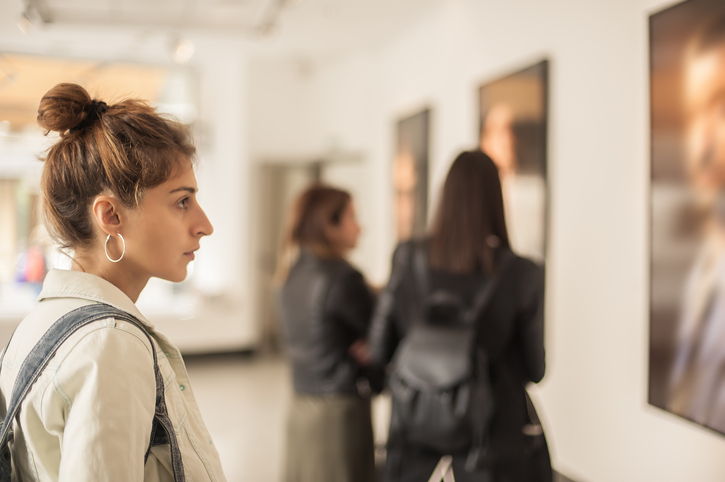
Imagine that you have been blindfolded and lead into in an art gallery.
You are positioned very close to a painting, so close in fact that the only thing getting in the way of you being physically merged with it are a few particles of nitrogen and oxygen.
Your blindfold is removed and after a few seconds you realise that in such close proximity, your vision is a little blurred so you edge a few centimetres back. Now you can see the definition of brush strokes that allow for the separation of one colour to the next.
A further step back reveals more detail, but you are still left guessing – is that part of an arm or a leg? Are they in a field or is it green carpet? What are you actually looking at?
It takes for a good few more steps back to see not only the subject and form of the painting, but also the enormity of it.
Now, with more distance between you and the painting, you can begin to understand what the artist was trying to portray and have clarity on the picture as a whole. You also notice the colour of the wall behind it, it’s placement on that wall among others on display, the presence of other visitors to the gallery and the size of the room itself.
You have found yourself to have a truer and more complete awareness of the painting in not only its own context, but that in which it sits.
All of this can be said for our own painting: our mind.
It is full of colour, complexities, thoughts, emotions, tasks and responsibilities and when we stand too close to it, we find it far too challenging to try and understand it and see it for what it really is.
When we experience overwhelmingly strong emotions such as stress and anxiety, we are standing too close to them. When we can’t prioritise our to-do list, we are standing too close it. When we feel we cannot cope with our day, we are standing too close to it.
With practice, we can learn to take a step back and observe our own painting without controlling it or judging it. Just accepting it for what it is.
Missed part one? Read our first Mindfulness March article here: Mindfulness March: Why Do Lawyers Need Mindfulness?
Mindfulness March: What Kind of Practice?
As with dinner parties, mindfulness can be practised formally and informally:
- Formal practice comes as mindful meditation, where we take a set amount of time out of our day to selectively tune into our mind (or painting, if you will) and observe what we find there. This can help us to gain a clearer perspective on our thoughts and feelings and set clear intentions for the day ahead.
- Informal practice is applying a mindful approach to any of our daily tasks so that we have a greater awareness of our experience of that task whilst doing it; really observing the taste and texture of a meal we are eating for example, really focusing on a conversation we are having, really focusing on the email we are writing.
When we do this, we not only find ourselves having a more enjoyable experience but a more productive one too.
We will come on to productivity, and a lawyer’s need and necessity for it, but first let’s look at the main anchor for mindfulness – the breath.
Mindfulness March: Mindful Breathing
Both formal and informal practice is initiated by getting in touch with a single act – the movement of our breath. By becoming aware of our in-breath and out-breath, we actively slow down our heartrate and subdue reactions from our central nervous system. This allows us to take a ‘step’ back from our mind and the intensity of the thoughts or feelings that may exist in it.
Whether you do this for ten minutes each morning, or in a series of short ‘awareness breaks’ throughout your day, it will help you gain greater clarity and control over your day as it unfolds.
You will be able to pace your workload better and increase your productivity as you will reduce the amount of distractions that may attempt to draw your focus away from a task in hand.
Mindfulness March: How Will This Help Lawyers?
For lawyers, by improving your focus, clarity of thought and reducing reactivity, mindfulness will help create better internal conditions for performance. By having a truer awareness of your own painting, you will find that stress will not get so much in the way of this performance.
Sometimes you have to slow down to speed up. By cultivating a greater bandwidth for paying attention, not only will your clients and colleagues benefit, but also yourself. It’s a win-win.
Mindfulness March: Homework
To truly believe in something, we have to experience it. So how about setting yourself a mini challenge and try connecting with your breath in any moment over the next week when you feel overwhelmed? See if you feel more grounded and more able to prioritise your workload, and lifeload, afterwards. Three minutes will do the job, who hasn’t got three minutes to spend on themselves? Think more mindful, less mind full.
“Mindfulness isn’t difficult, we just need to remember to do it,” Sharon Saltzberg.
Published: 19/03/18 Author: Liz Davies, Founder of Phoenix Reiki
More Top Tips for Students:
- Mindfulness March: Why Do Lawyers Need Mindfulness?
- 4 Key Ways You Can Look After Your Mental Health at University
- 3 Top Lessons for a First Year Law Student
